Attached files
| file | filename |
|---|---|
| 8-K - 8-K - American Railcar Industries, Inc. | q12017results8k.htm |
| EX-99.1 - EXHIBIT 99.1 - American Railcar Industries, Inc. | ariiex991q12017.htm |
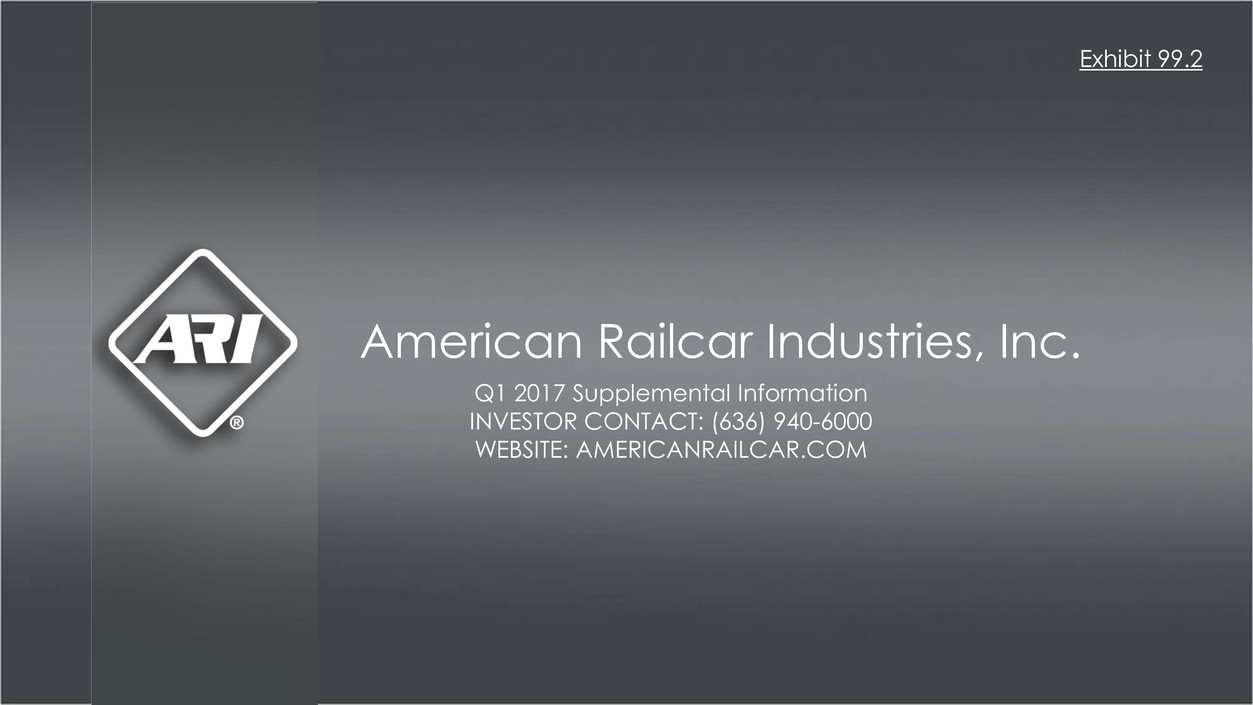
Q1 2017 Supplemental Information
INVESTOR CONTACT: (636) 940-6000
WEBSITE: AMERICANRAILCAR.COM
American Railcar Industries, Inc.
Exhibit 99.2
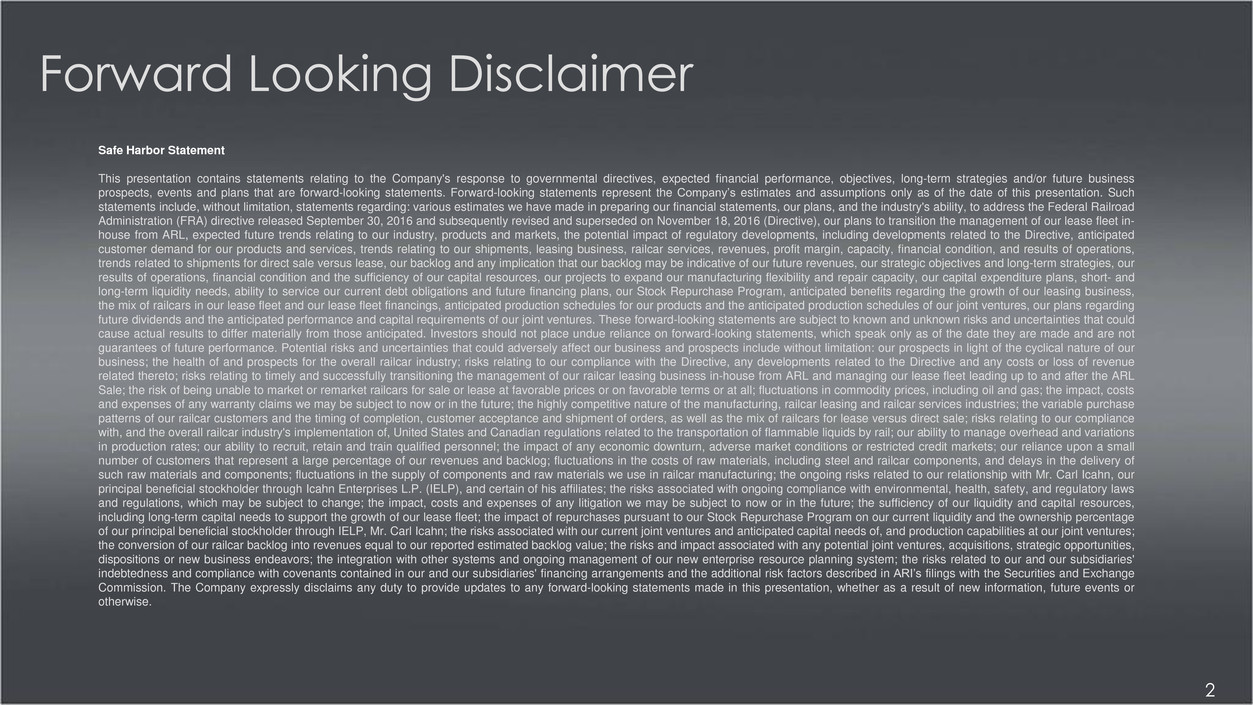
Forward Looking Disclaimer
2
Safe Harbor Statement
This presentation contains statements relating to the Company's response to governmental directives, expected financial performance, objectives, long-term strategies and/or future business
prospects, events and plans that are forward-looking statements. Forward-looking statements represent the Company’s estimates and assumptions only as of the date of this presentation. Such
statements include, without limitation, statements regarding: various estimates we have made in preparing our financial statements, our plans, and the industry's ability, to address the Federal Railroad
Administration (FRA) directive released September 30, 2016 and subsequently revised and superseded on November 18, 2016 (Directive), our plans to transition the management of our lease fleet in-
house from ARL, expected future trends relating to our industry, products and markets, the potential impact of regulatory developments, including developments related to the Directive, anticipated
customer demand for our products and services, trends relating to our shipments, leasing business, railcar services, revenues, profit margin, capacity, financial condition, and results of operations,
trends related to shipments for direct sale versus lease, our backlog and any implication that our backlog may be indicative of our future revenues, our strategic objectives and long-term strategies, our
results of operations, financial condition and the sufficiency of our capital resources, our projects to expand our manufacturing flexibility and repair capacity, our capital expenditure plans, short- and
long-term liquidity needs, ability to service our current debt obligations and future financing plans, our Stock Repurchase Program, anticipated benefits regarding the growth of our leasing business,
the mix of railcars in our lease fleet and our lease fleet financings, anticipated production schedules for our products and the anticipated production schedules of our joint ventures, our plans regarding
future dividends and the anticipated performance and capital requirements of our joint ventures. These forward-looking statements are subject to known and unknown risks and uncertainties that could
cause actual results to differ materially from those anticipated. Investors should not place undue reliance on forward-looking statements, which speak only as of the date they are made and are not
guarantees of future performance. Potential risks and uncertainties that could adversely affect our business and prospects include without limitation: our prospects in light of the cyclical nature of our
business; the health of and prospects for the overall railcar industry; risks relating to our compliance with the Directive, any developments related to the Directive and any costs or loss of revenue
related thereto; risks relating to timely and successfully transitioning the management of our railcar leasing business in-house from ARL and managing our lease fleet leading up to and after the ARL
Sale; the risk of being unable to market or remarket railcars for sale or lease at favorable prices or on favorable terms or at all; fluctuations in commodity prices, including oil and gas; the impact, costs
and expenses of any warranty claims we may be subject to now or in the future; the highly competitive nature of the manufacturing, railcar leasing and railcar services industries; the variable purchase
patterns of our railcar customers and the timing of completion, customer acceptance and shipment of orders, as well as the mix of railcars for lease versus direct sale; risks relating to our compliance
with, and the overall railcar industry's implementation of, United States and Canadian regulations related to the transportation of flammable liquids by rail; our ability to manage overhead and variations
in production rates; our ability to recruit, retain and train qualified personnel; the impact of any economic downturn, adverse market conditions or restricted credit markets; our reliance upon a small
number of customers that represent a large percentage of our revenues and backlog; fluctuations in the costs of raw materials, including steel and railcar components, and delays in the delivery of
such raw materials and components; fluctuations in the supply of components and raw materials we use in railcar manufacturing; the ongoing risks related to our relationship with Mr. Carl Icahn, our
principal beneficial stockholder through Icahn Enterprises L.P. (IELP), and certain of his affiliates; the risks associated with ongoing compliance with environmental, health, safety, and regulatory laws
and regulations, which may be subject to change; the impact, costs and expenses of any litigation we may be subject to now or in the future; the sufficiency of our liquidity and capital resources,
including long-term capital needs to support the growth of our lease fleet; the impact of repurchases pursuant to our Stock Repurchase Program on our current liquidity and the ownership percentage
of our principal beneficial stockholder through IELP, Mr. Carl Icahn; the risks associated with our current joint ventures and anticipated capital needs of, and production capabilities at our joint ventures;
the conversion of our railcar backlog into revenues equal to our reported estimated backlog value; the risks and impact associated with any potential joint ventures, acquisitions, strategic opportunities,
dispositions or new business endeavors; the integration with other systems and ongoing management of our new enterprise resource planning system; the risks related to our and our subsidiaries'
indebtedness and compliance with covenants contained in our and our subsidiaries' financing arrangements and the additional risk factors described in ARI’s filings with the Securities and Exchange
Commission. The Company expressly disclaims any duty to provide updates to any forward-looking statements made in this presentation, whether as a result of new information, future events or
otherwise.
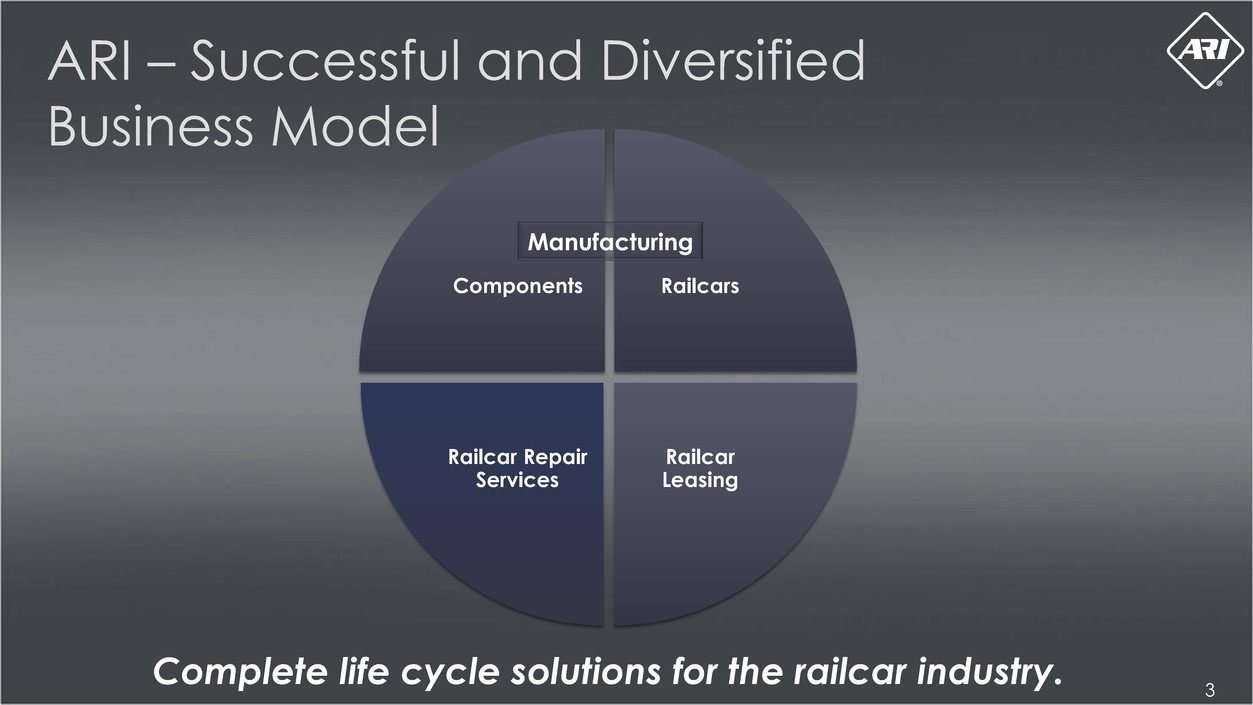
ARI – Successful and Diversified
Business Model
3
Complete life cycle solutions for the railcar industry.
Components Railcars
Railcar
Leasing
Railcar Repair
Services
Manufacturing
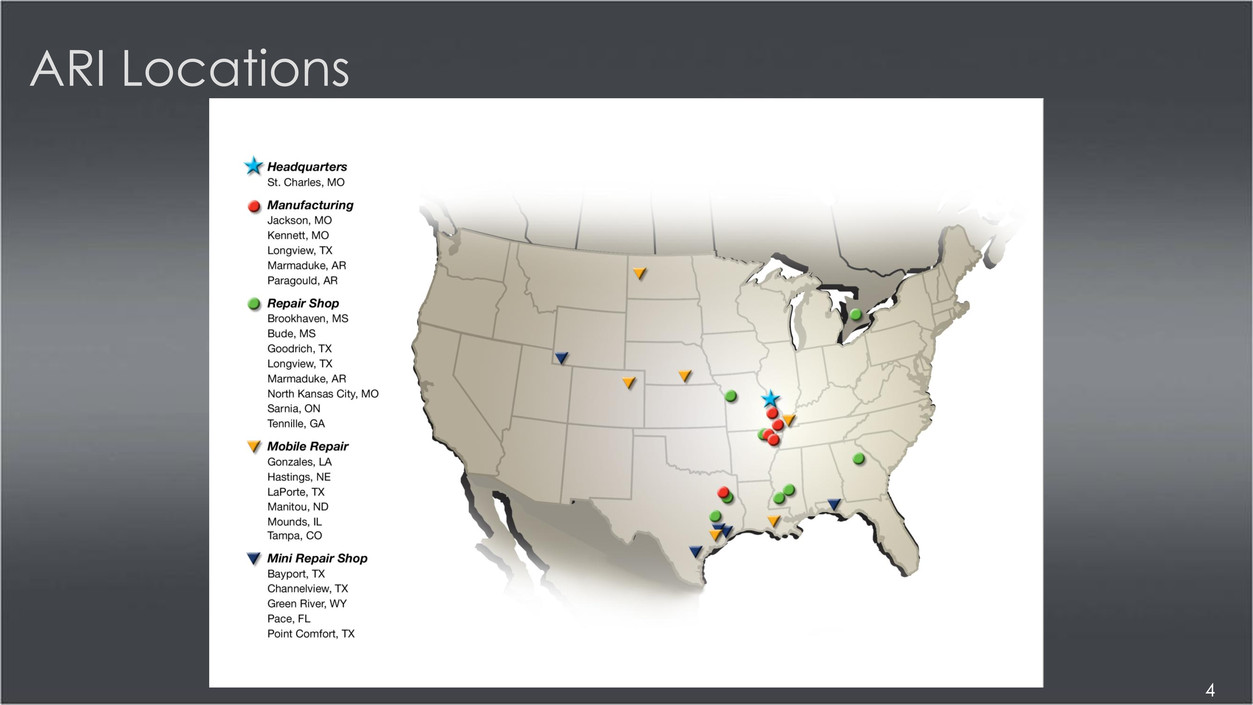
ARI Locations
4
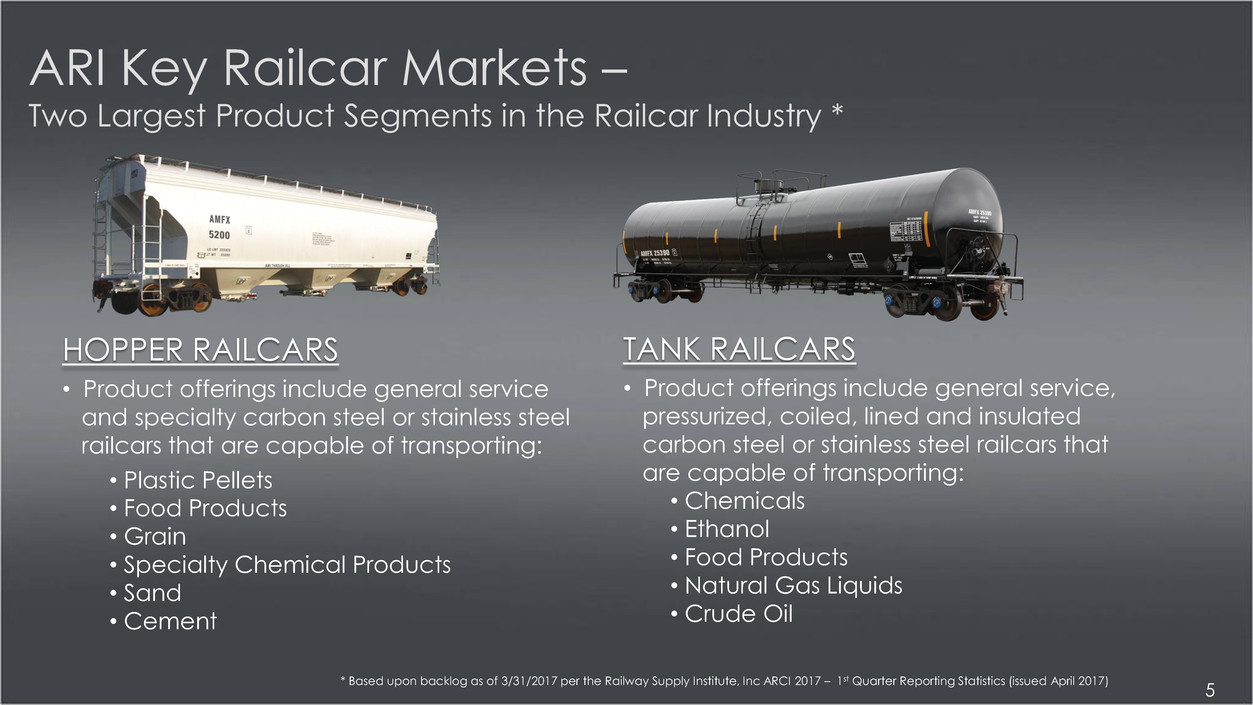
ARI Key Railcar Markets –
Two Largest Product Segments in the Railcar Industry *
TANK RAILCARS
• Product offerings include general service,
pressurized, coiled, lined and insulated
carbon steel or stainless steel railcars that
are capable of transporting:
• Chemicals
• Ethanol
• Food Products
• Natural Gas Liquids
• Crude Oil
HOPPER RAILCARS
• Product offerings include general service
and specialty carbon steel or stainless steel
railcars that are capable of transporting:
• Plastic Pellets
• Food Products
• Grain
• Specialty Chemical Products
• Sand
• Cement
* Based upon backlog as of 3/31/2017 per the Railway Supply Institute, Inc ARCI 2017 – 1st Quarter Reporting Statistics (issued April 2017)
5
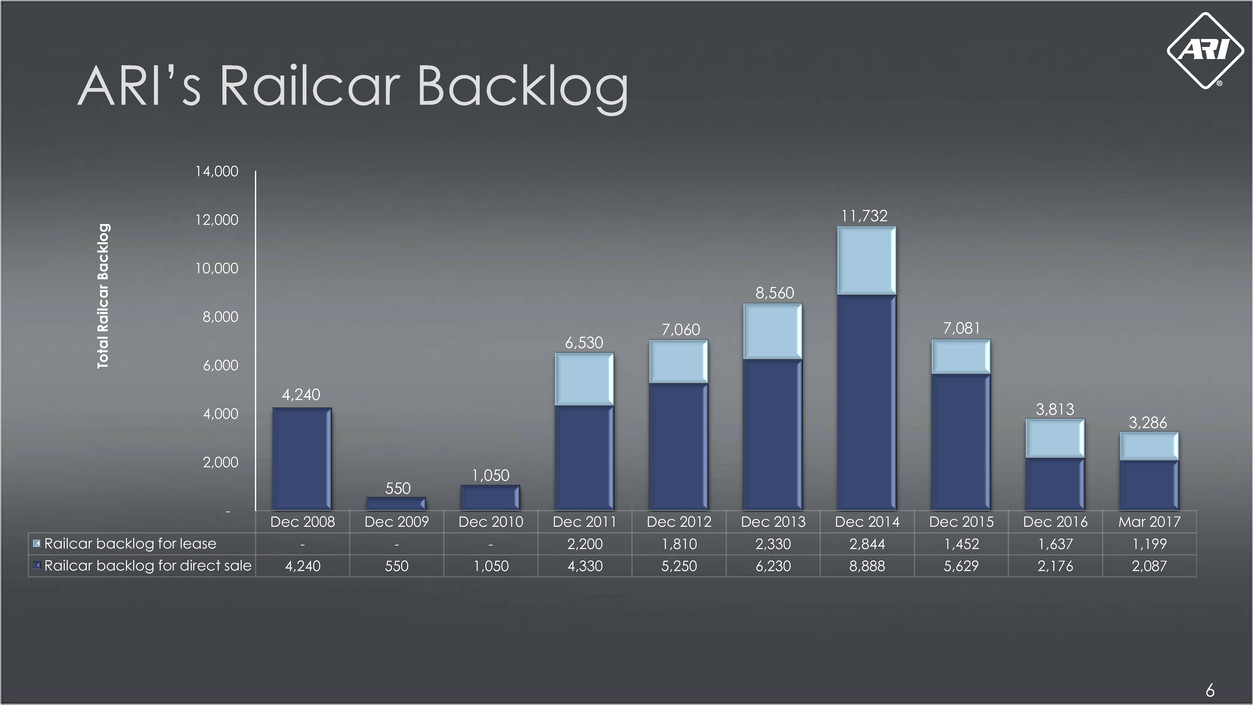
ARI’s Railcar Backlog
6
Dec 2008 Dec 2009 Dec 2010 Dec 2011 Dec 2012 Dec 2013 Dec 2014 Dec 2015 Dec 2016 Mar 2017
Railcar backlog for lease - - - 2,200 1,810 2,330 2,844 1,452 1,637 1,199
Railcar backlog for direct sale 4,240 550 1,050 4,330 5,250 6,230 8,888 5,629 2,176 2,087
-
2,000
4,000
6,000
8,000
10,000
12,000
14,000
To
ta
l R
a
ilcar
B
a
ck
lo
g
1,050
6,530
7,060
8,560
11,732
7,081
4,240
550
3,813
3,286

Manufacturing Segment
• Flexible and labor efficient
manufacturing facilities
• Strategic locations near customers
and major rail lines
• Vertical integration from joint ventures
and component manufacturing
• Experienced core group of
employees
• Ability to adapt to evolving customer
demands
7
-10%
-5%
0%
5%
10%
15%
20%
25%
30%
$-
$200
$400
$600
$800
$1,000
$1,200
2008 2009 2010 2011 2012 2013 2014 2015 2016 Q1
2017
TTM
Revenue Operating Margin % ^ (millions)
^: Manufacturing segment revenues and operating margin % presented above include an
estimate of revenue and profit, respectively, for railcars built for our lease fleet. Such revenues
and profit are based on an estimated fair market value of the leased railcars as if they had been
sold to a third party, less the cost to manufacture for operating margin %. Estimated revenues
related to railcars built for our lease fleet are eliminated in consolidation.
Q1 2017 TTM and 2016 both include impact of
~2%, or $12.3 million, for the loss contingency
reserve related to the FRA Directive.
Broad manufacturing base allows ARI to be competitive and provide quality railcars and components
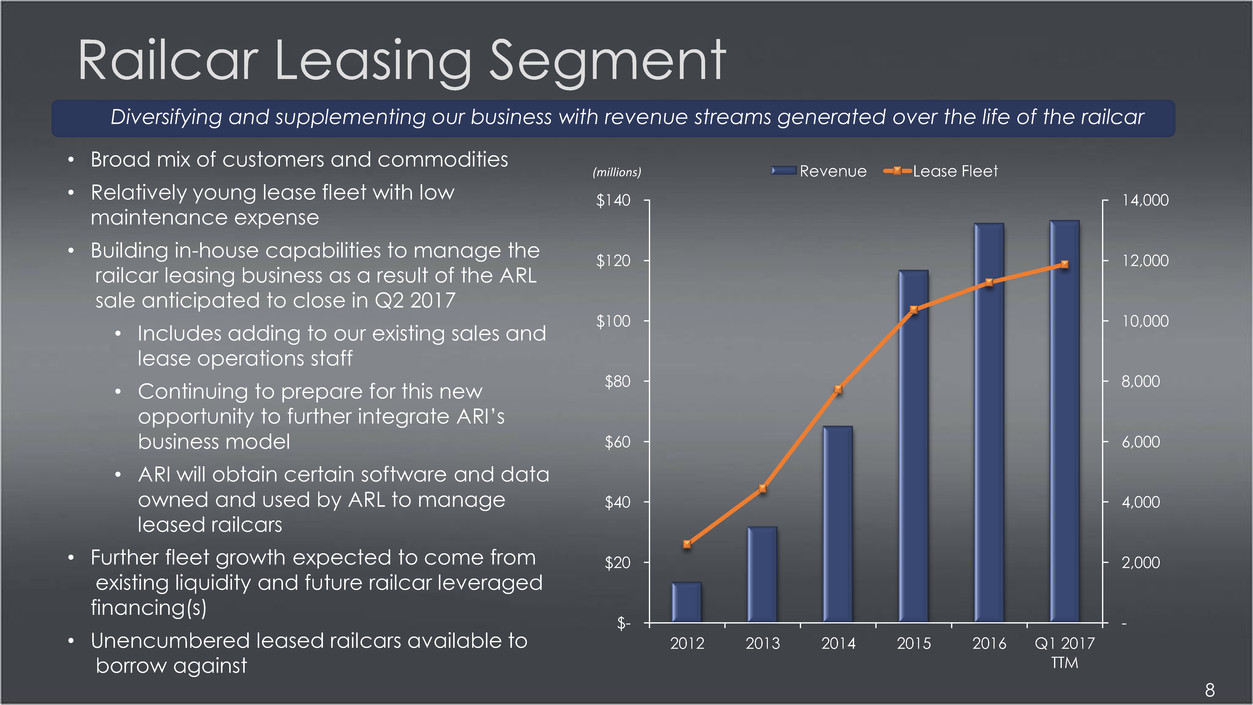
Railcar Leasing Segment
-
2,000
4,000
6,000
8,000
10,000
12,000
14,000
$-
$20
$40
$60
$80
$100
$120
$140
2012 2013 2014 2015 2016 Q1 2017
TTM
Revenue Lease Fleet (millions)
• Broad mix of customers and commodities
• Relatively young lease fleet with low
maintenance expense
• Building in-house capabilities to manage the
railcar leasing business as a result of the ARL
sale anticipated to close in Q2 2017
• Includes adding to our existing sales and
lease operations staff
• Continuing to prepare for this new
opportunity to further integrate ARI’s
business model
• ARI will obtain certain software and data
owned and used by ARL to manage
leased railcars
• Further fleet growth expected to come from
existing liquidity and future railcar leveraged
financing(s)
• Unencumbered leased railcars available to
borrow against
8
Diversifying and supplementing our business with revenue streams generated over the life of the railcar
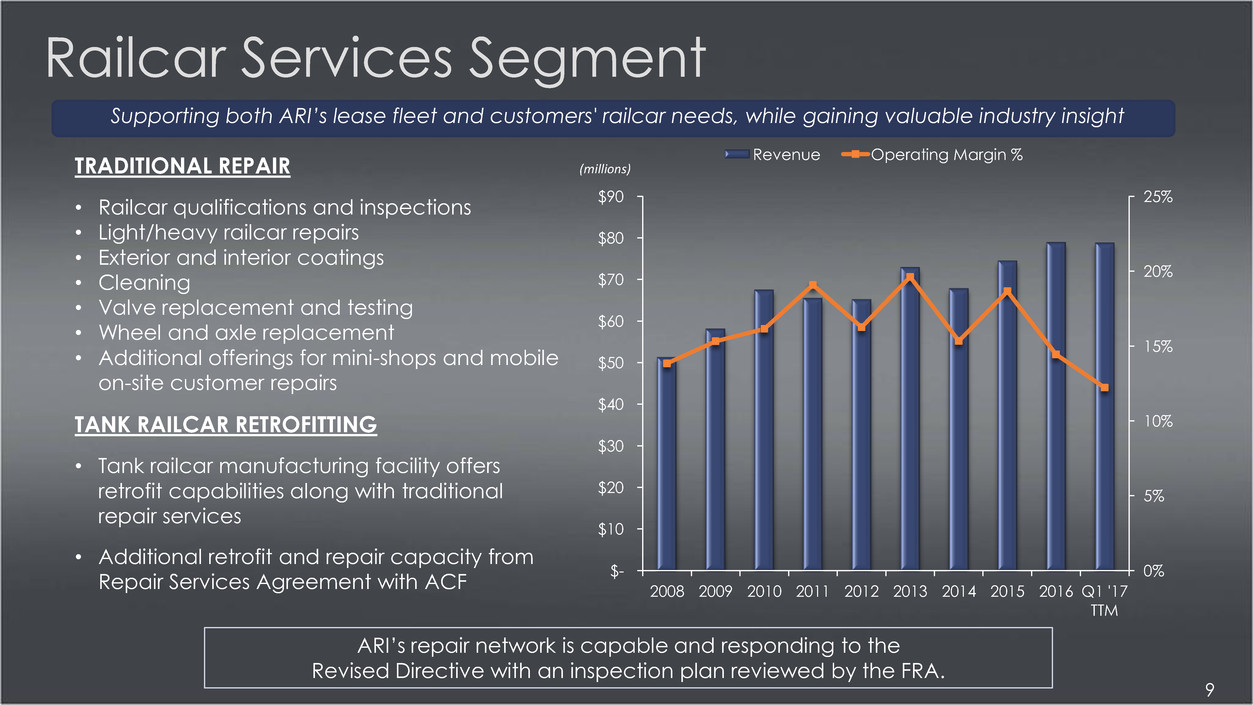
Railcar Services Segment
TRADITIONAL REPAIR
• Railcar qualifications and inspections
• Light/heavy railcar repairs
• Exterior and interior coatings
• Cleaning
• Valve replacement and testing
• Wheel and axle replacement
• Additional offerings for mini-shops and mobile
on-site customer repairs
TANK RAILCAR RETROFITTING
• Tank railcar manufacturing facility offers
retrofit capabilities along with traditional
repair services
• Additional retrofit and repair capacity from
Repair Services Agreement with ACF
9
0%
5%
10%
15%
20%
25%
$-
$10
$20
$30
$40
$50
$60
$70
$80
$90
2008 2009 2010 2011 2012 2013 2014 2015 2016 Q1 '17
TTM
Revenue Operating Margin %
(millions)
Supporting both ARI’s lease fleet and customers' railcar needs, while gaining valuable industry insight
ARI’s repair network is capable and responding to the
Revised Directive with an inspection plan reviewed by the FRA.
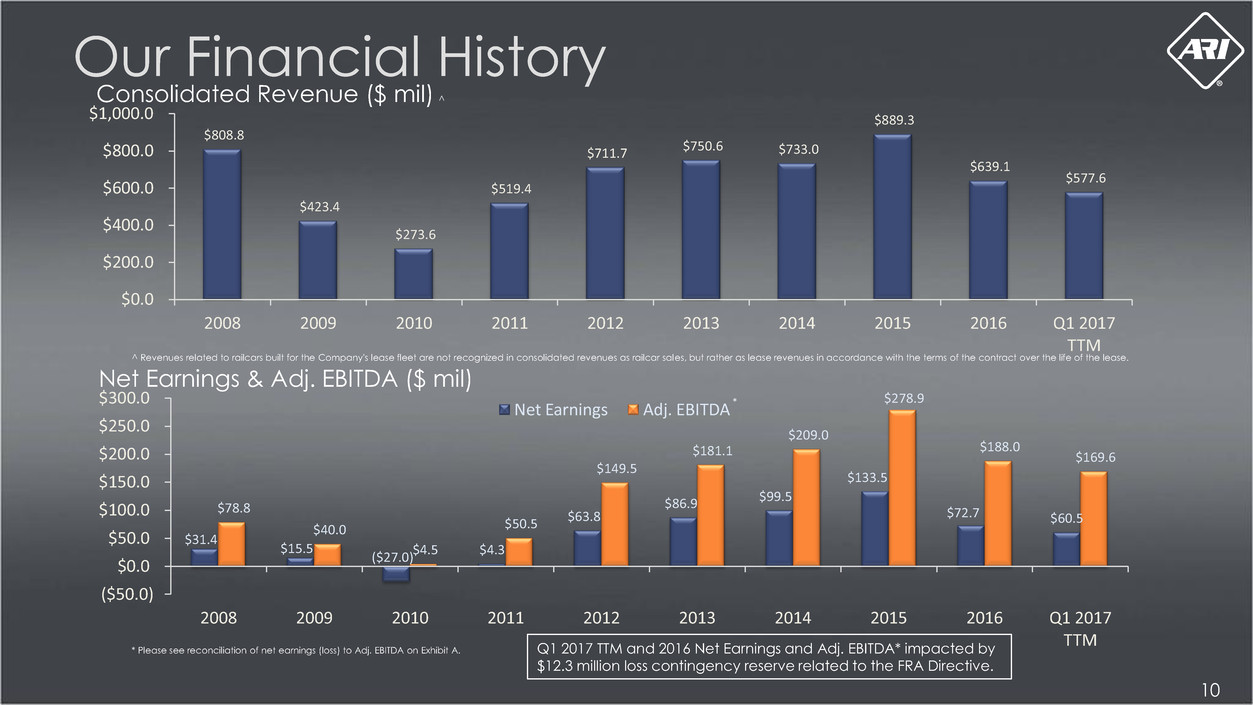
Our Financial History
$808.8
$423.4
$273.6
$519.4
$711.7
$750.6 $733.0
$889.3
$639.1
$577.6
$0.0
$200.0
$400.0
$600.0
$800.0
$1,000.0
2008 2009 2010 2011 2012 2013 2014 2015 2016 Q1 2017
TTM
^ Revenues related to railcars built for the Company's lease fleet are not recognized in consolidated revenues as railcar sales, but rather as lease revenues in accordance with the terms of the contract over the life of the lease.
$31.4
$15.5
($27.0)
$4.3
$63.8
$86.9 $99.5
$133.5
$72.7 $60.5
$78.8
$40.0
$4.5
$50.5
$149.5
$181.1
$209.0
$278.9
$188.0
$169.6
($50.0)
$0.0
$50.0
$100.0
$150.0
$200.0
$250.0
$300.0
2008 2009 2010 2011 2012 2013 2014 2015 2016 Q1 2017
TTM
Net Earnings Adj. EBITDA
*
* Please see reconciliation of net earnings (loss) to Adj. EBITDA on Exhibit A.
10
Consolidated Revenue ($ mil) ^
Net Earnings & Adj. EBITDA ($ mil)
Q1 2017 TTM and 2016 Net Earnings and Adj. EBITDA* impacted by
$12.3 million loss contingency reserve related to the FRA Directive.
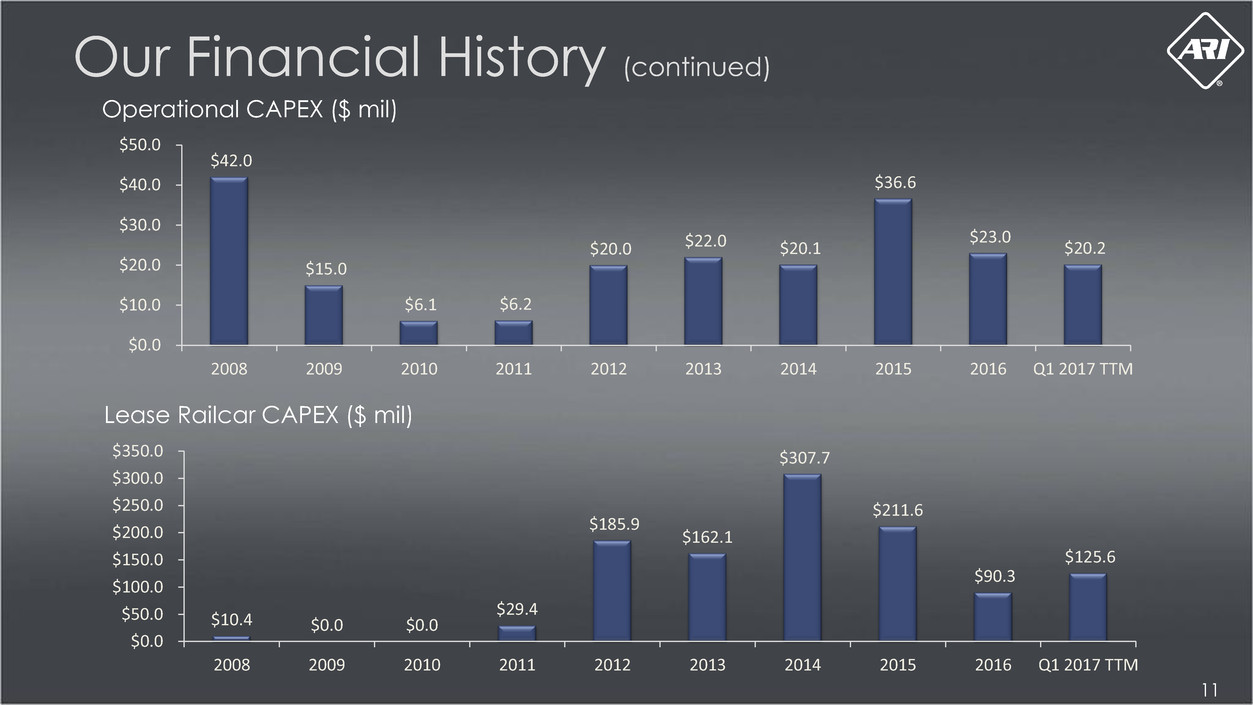
Our Financial History (continued)
$10.4 $0.0 $0.0
$29.4
$185.9
$162.1
$307.7
$211.6
$90.3
$125.6
$0.0
$50.0
$100.0
$150.0
$200.0
$250.0
$300.0
$350.0
2008 2009 2010 2011 2012 2013 2014 2015 2016 Q1 2017 TTM
Lease Railcar CAPEX ($ mil)
Operational CAPEX ($ mil)
$42.0
$15.0
$6.1 $6.2
$20.0 $22.0 $20.1
$36.6
$23.0
$20.2
$0.0
$10.0
$20.0
$30.0
$40.0
$50.0
2008 2009 2010 2011 2012 2013 2014 2015 2016 Q1 2017 TTM
11
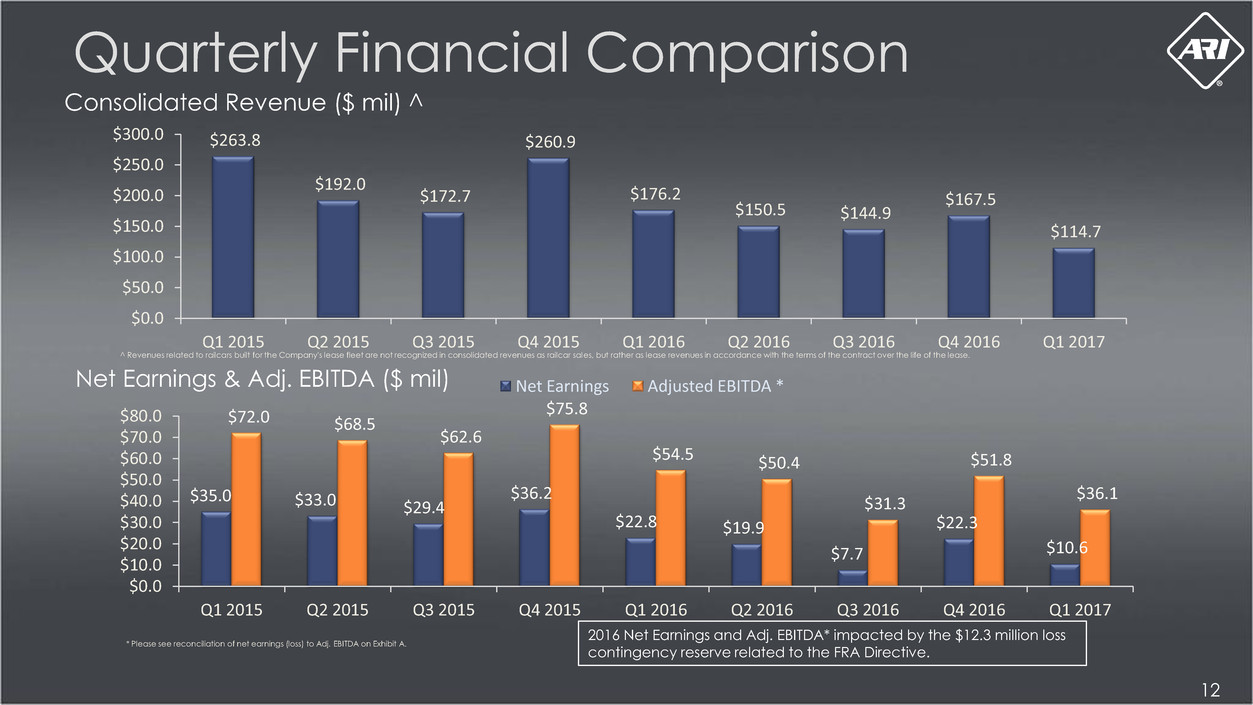
Quarterly Financial Comparison
$263.8
$192.0
$172.7
$260.9
$176.2
$150.5 $144.9
$167.5
$114.7
$0.0
$50.0
$100.0
$150.0
$200.0
$250.0
$300.0
Q1 2015 Q2 2015 Q3 2015 Q4 2015 Q1 2016 Q2 2016 Q3 2016 Q4 2016 Q1 2017
^ Revenues related to railcars built for the Company's lease fleet are not recognized in consolidated revenues as railcar sales, but rather as lease revenues in accordance with the terms of the contract over the life of the lease.
$35.0 $33.0 $29.4
$36.2
$22.8 $19.9
$7.7
$22.3
$10.6
$72.0 $68.5
$62.6
$75.8
$54.5 $50.4
$31.3
$51.8
$36.1
$0.0
$10.0
$20.0
$30.0
$40.0
$50.0
$60.0
$70.0
$80.0
Q1 2015 Q2 2015 Q3 2015 Q4 2015 Q1 2016 Q2 2016 Q3 2016 Q4 2016 Q1 2017
Net Earnings Adjusted EBITDA *
* Please see reconciliation of net earnings (loss) to Adj. EBITDA on Exhibit A.
Net Earnings & Adj. EBITDA ($ mil)
Consolidated Revenue ($ mil) ^
12
2016 Net Earnings and Adj. EBITDA* impacted by the $12.3 million loss
contingency reserve related to the FRA Directive.
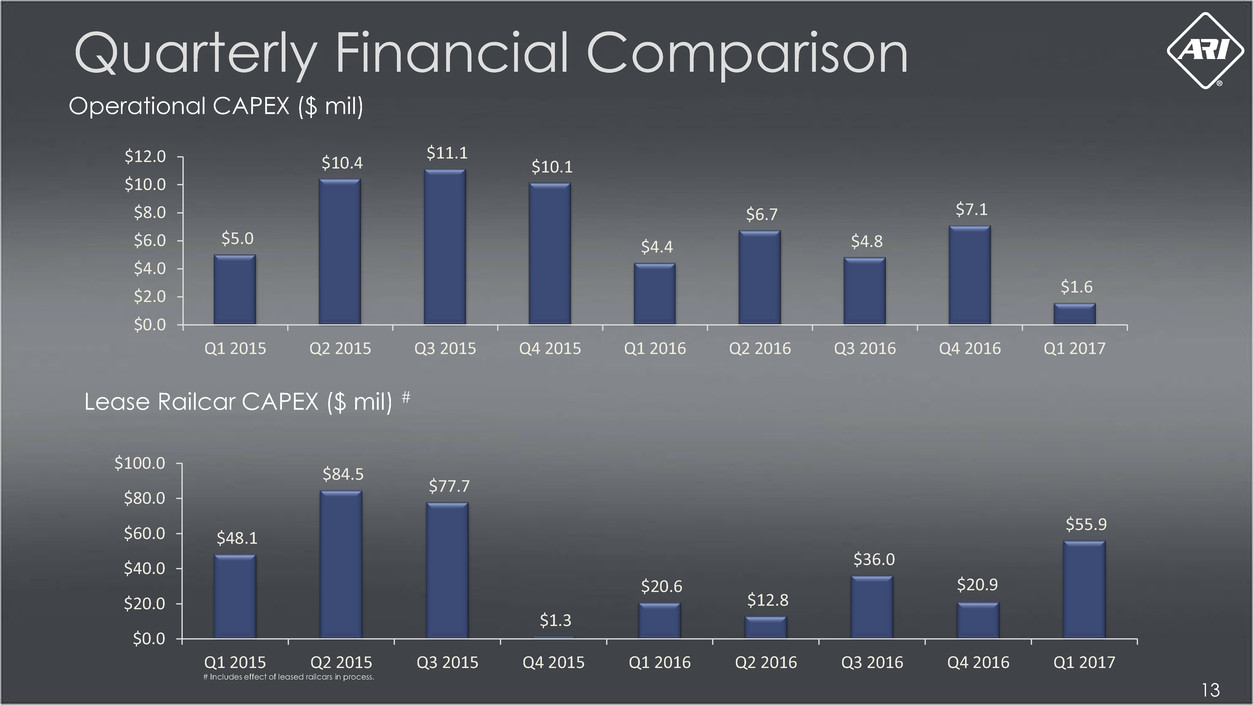
Quarterly Financial Comparison
$5.0
$10.4
$11.1
$10.1
$4.4
$6.7
$4.8
$7.1
$1.6
$0.0
$2.0
$4.0
$6.0
$8.0
$10.0
$12.0
Q1 2015 Q2 2015 Q3 2015 Q4 2015 Q1 2016 Q2 2016 Q3 2016 Q4 2016 Q1 2017
$48.1
$84.5
$77.7
$1.3
$20.6
$12.8
$36.0
$20.9
$55.9
$0.0
$20.0
$40.0
$60.0
$80.0
$100.0
Q1 2015 Q2 2015 Q3 2015 Q4 2015 Q1 2016 Q2 2016 Q3 2016 Q4 2016 Q1 2017
# Includes effect of leased railcars in process.
Operational CAPEX ($ mil)
Lease Railcar CAPEX ($ mil) #
13
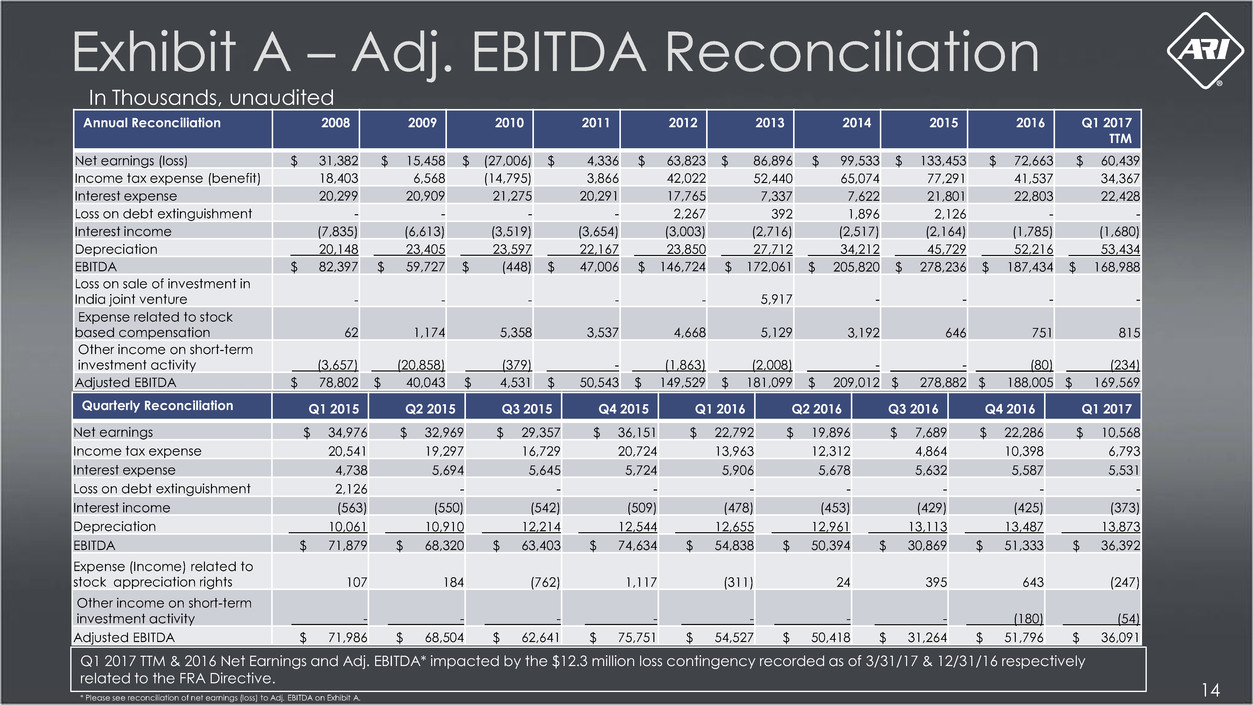
Exhibit A – Adj. EBITDA Reconciliation
Annual Reconciliation 2008 2009 2010 2011 2012 2013 2014 2015 2016 Q1 2017
TTM
Net earnings (loss) $ 31,382 $ 15,458 $ (27,006) $ 4,336 $ 63,823 $ 86,896 $ 99,533 $ 133,453 $ 72,663 $ 60,439
Income tax expense (benefit) 18,403 6,568 (14,795) 3,866 42,022 52,440 65,074 77,291 41,537 34,367
Interest expense 20,299 20,909 21,275 20,291 17,765 7,337 7,622 21,801 22,803 22,428
Loss on debt extinguishment - - - - 2,267 392 1,896 2,126 - -
Interest income (7,835) (6,613) (3,519) (3,654) (3,003) (2,716) (2,517) (2,164) (1,785) (1,680)
Depreciation 20,148 23,405 23,597 22,167 23,850 27,712 34,212 45,729 52,216 53,434
EBITDA $ 82,397 $ 59,727 $ (448) $ 47,006 $ 146,724 $ 172,061 $ 205,820 $ 278,236 $ 187,434 $ 168,988
Loss on sale of investment in
India joint venture - - - - - 5,917 - - - -
Expense related to stock
based compensation
62
1,174
5,358
3,537
4,668
5,129 3,192 646 751 815
Other income on short-term
investment activity (3,657) (20,858) (379) - (1,863) (2,008) - - (80) (234)
Adjusted EBITDA $ 78,802 $ 40,043 $ 4,531 $ 50,543 $ 149,529 $ 181,099 $ 209,012 $ 278,882 $ 188,005 $ 169,569
Quarterly Reconciliation Q1 2015 Q2 2015 Q3 2015 Q4 2015 Q1 2016 Q2 2016 Q3 2016 Q4 2016 Q1 2017
Net earnings $ 34,976 $ 32,969 $ 29,357 $ 36,151 $ 22,792 $ 19,896 $ 7,689 $ 22,286 $ 10,568
Income tax expense 20,541 19,297 16,729 20,724 13,963 12,312 4,864 10,398 6,793
Interest expense 4,738 5,694 5,645 5,724 5,906 5,678 5,632 5,587 5,531
Loss on debt extinguishment 2,126 - - - - - - - -
Interest income (563) (550) (542) (509) (478) (453) (429) (425) (373)
Depreciation 10,061 10,910 12,214 12,544 12,655 12,961 13,113 13,487 13,873
EBITDA $ 71,879 $ 68,320 $ 63,403 $ 74,634 $ 54,838 $ 50,394 $ 30,869 $ 51,333 $ 36,392
Expense (Income) related to
stock appreciation rights 107 184 (762) 1,117 (311) 24 395 643 (247)
Other income on short-term
investment activity - - - - - - - (180) (54)
Adjusted EBITDA $ 71,986 $ 68,504 $ 62,641 $ 75,751 $ 54,527 $ 50,418 $ 31,264 $ 51,796 $ 36,091
In Thousands, unaudited
14
Q1 2017 TTM & 2016 Net Earnings and Adj. EBITDA* impacted by the $12.3 million loss contingency recorded as of 3/31/17 & 12/31/16 respectively
related to the FRA Directive.
* Please see reconciliation of net earnings (loss) to Adj. EBITDA on Exhibit A.
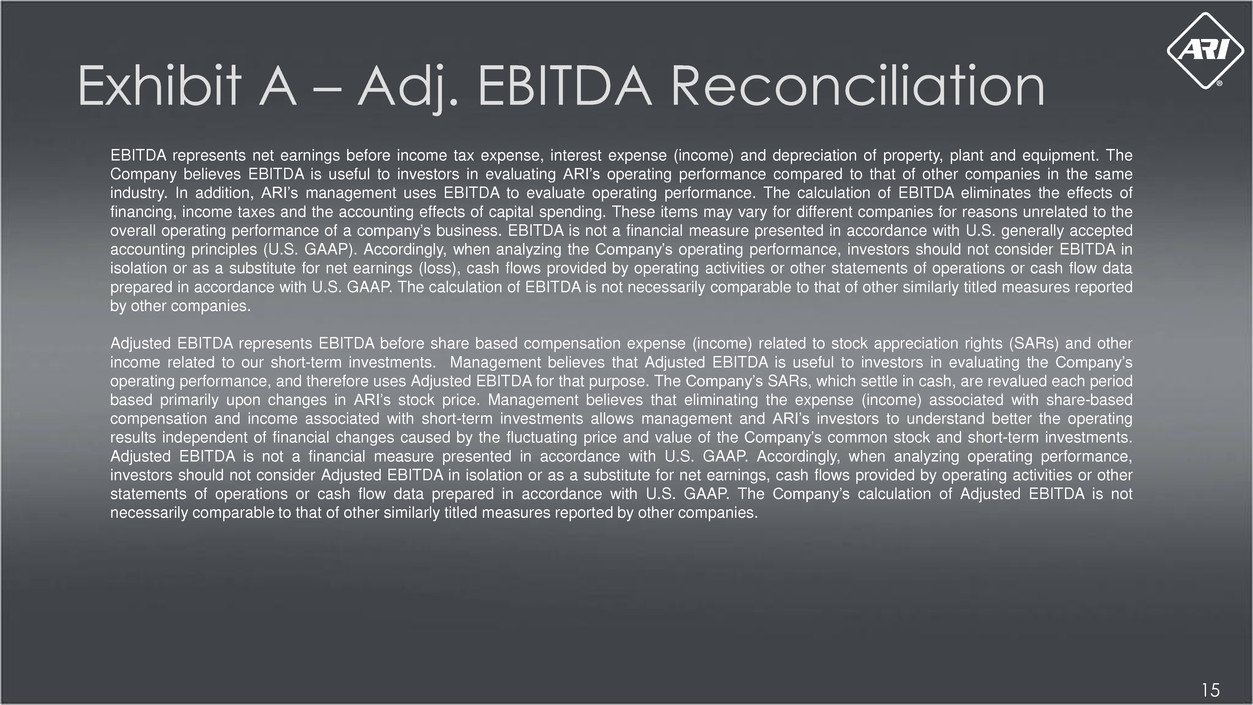
Exhibit A – Adj. EBITDA Reconciliation
EBITDA represents net earnings before income tax expense, interest expense (income) and depreciation of property, plant and equipment. The
Company believes EBITDA is useful to investors in evaluating ARI’s operating performance compared to that of other companies in the same
industry. In addition, ARI’s management uses EBITDA to evaluate operating performance. The calculation of EBITDA eliminates the effects of
financing, income taxes and the accounting effects of capital spending. These items may vary for different companies for reasons unrelated to the
overall operating performance of a company’s business. EBITDA is not a financial measure presented in accordance with U.S. generally accepted
accounting principles (U.S. GAAP). Accordingly, when analyzing the Company’s operating performance, investors should not consider EBITDA in
isolation or as a substitute for net earnings (loss), cash flows provided by operating activities or other statements of operations or cash flow data
prepared in accordance with U.S. GAAP. The calculation of EBITDA is not necessarily comparable to that of other similarly titled measures reported
by other companies.
Adjusted EBITDA represents EBITDA before share based compensation expense (income) related to stock appreciation rights (SARs) and other
income related to our short-term investments. Management believes that Adjusted EBITDA is useful to investors in evaluating the Company’s
operating performance, and therefore uses Adjusted EBITDA for that purpose. The Company’s SARs, which settle in cash, are revalued each period
based primarily upon changes in ARI’s stock price. Management believes that eliminating the expense (income) associated with share-based
compensation and income associated with short-term investments allows management and ARI’s investors to understand better the operating
results independent of financial changes caused by the fluctuating price and value of the Company’s common stock and short-term investments.
Adjusted EBITDA is not a financial measure presented in accordance with U.S. GAAP. Accordingly, when analyzing operating performance,
investors should not consider Adjusted EBITDA in isolation or as a substitute for net earnings, cash flows provided by operating activities or other
statements of operations or cash flow data prepared in accordance with U.S. GAAP. The Company’s calculation of Adjusted EBITDA is not
necessarily comparable to that of other similarly titled measures reported by other companies.
15
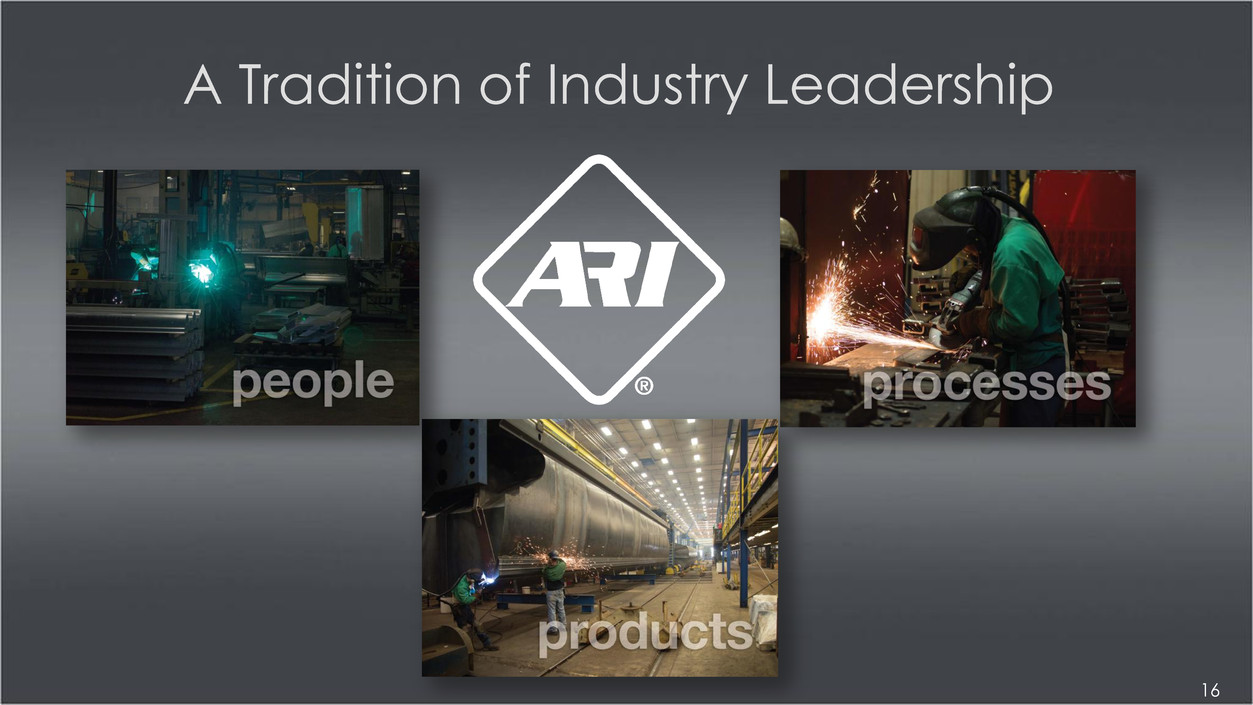
A Tradition of Industry Leadership
16
